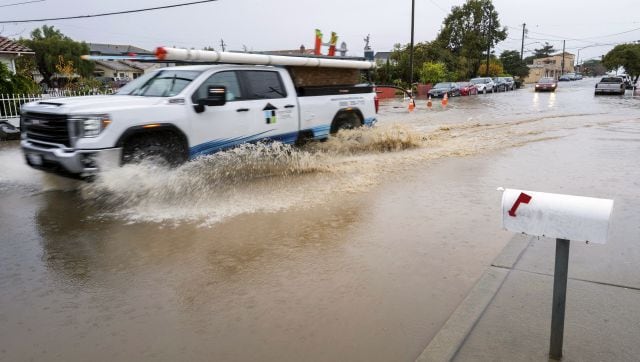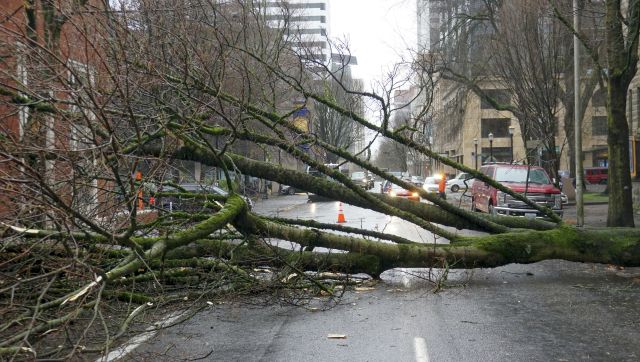It’s a paradox of weather conditions. While the East Coast of the United States — spanning from North Carolina all the way up to Colorado and Montana — has been struggling with a severe winter storm, the West Coast is battling heavy rain, wind and flooding as a powerful storm system sweeps across the region.
The extreme winter, which has been described as a ‘once-in-a-generational’ event by the National Weather Service (NWS), has led to the deaths of 62 people, and leaving thousands without any power. In Buffalo, which was severely hit by the blizzard, the military police have been brought in to help manage traffic in the city. The winter storm has also forced the cancellation of thousands of flights. Thousands of passengers have been left stranded at airports across the country.
Now, as the East Coast digs itself out of layers of snow, several western states such as northern California, Oregon and Washington are witnessing heavy rain, with many areas placed under a flood watch.
Weather experts state that the severe weather event is an “atmospheric river”, which is likely to bring days of heavy rain.
What exactly is an atmospheric river and what is the impact of this weather phenomenon in the US? We take a look.
Atmospheric rivers, explained
Atmospheric rivers are long, narrow regions in the atmosphere like rivers in the sky that transport most of the water vapour outside of the tropical region. This atmospheric water steams or columns of moisture travel great distances. When the atmospheric rivers make landfall, they often release this water vapour in the form of rain or snow.
According to the US-based National Oceanic and Atmospheric Administration (NOAA), when these atmospheric rivers move inland and sweep over mountains, the water vapour rises and cools to create heavy rainfall or snowfall.
People walk along a rain-soaked Great Highway in San Francisco, California. AP
The term was first used in a 1994 research paper and is now widely used by meteorologists. A popular example of such a phenomenon is the “Pineapple Express”, a strong atmospheric river that is capable of bringing moisture from the tropics near Hawaii over to the US west coast.
According to the NOAA, while not all atmospheric rivers cause damage, they often contain an incredible amount of moisture. According to the NOAA, these columns can carry roughly 7.5 to 15 times the average flow of water at the mouth of the Mississippi River.
A separate University of Reading study in 2013 found one atmospheric river in 2009 over the United Kingdom contained 4,500 times more water than the average flow in the River Thames in London.
The NOAA also states that atmospheric rivers are essential — up to half of the average annual precipitation near the West Coast of the US comes from atmospheric rivers.
Also known as a tropical plume, tropical connection, moisture plume, water vapour surge, or cloud band, this weather phenomenon isn’t only limited to the United States. Atmospheric rivers occur globally, affecting the West Coasts of the world’s major land masses, including Portugal, Western Europe, Chile and South Africa.
Atmospheric rivers are also important, as they provide beneficial amounts of rain for the water supply. According to the NOAA, they help increase California’s mountain snowpack, which provides a third of the state’s water supply.
Atmospheric rivers are ranked on a scale of 1-5 based on how much moisture they transport, with category 4 or 5 atmospheric rivers capable of producing large quantities of rain, resulting in severe flooding, mudslides and catastrophic damage to life and property.
Impact of atmospheric river on West Coast
This atmospheric river has brought heavy rain to all 11 states on the West Coast, with the heaviest impacts felt in California.
In California, heavy rainfall has flooded roadways and strong winds have torn down trees, adding new travel hazards for commuters. According to a report in The Guardian, San Francisco had received more than an inch of rain while Mount Tamalpais in the northern Bay Area had more than four inches of rainfall by Wednesday.

A truck drives through a flooded intersection of E Bolivar Street in Salinas, California. AP
Portland too witnessed heavy rain with areas west of the city seeing up to six inches of precipitation. On Monday, the city broke its past record of heavy rainfall — it witnessed 2.12 inches of rain, topping the record of 1.08 inches set on 26 December 1996.
In Olympia, Washington, officials reported a record high tide of 18.4 feet. The heavy rain had submerged parts of the city, with Eric Christensen, Olympia water resources director telling CBS News that “jellyfish washed over the shoreline and into our streets”.
Seattle too witnessed heavy rainfall, resulting in flooding, which trapped cars and impacted buildings. The Seattle Times reported that more than one dozen homes were flooded. The daily also reported that 53 flights to and from Seattle-Tacoma International Airport were cancelled on Wednesday.

A large tree lies in the middle of the road after falling over and blocking southwest Jefferson Street near the Portland Art Museum in Portland, Oregon. The region is experiencing high winds, and the National Weather Service has issued a high wind advisory. AP
The heavy rainfall has also snapped power lines, with poweroutage.us — that tracks power interruptions — reporting that some 50,000 customers were without power across Oregon. Similarly, some 25,000 people were without power in California and Washington state.
In Oregon, the severe weather had caused three fatal accidents, according to the authorities. On Tuesday, a tree fell onto the roof of a car that was driving eastbound on Highway 26, killing a 19-year-old driver and two passengers. Several hours later, a tree toppled and landed on a truck, killing the 53-year-old driver. The third accident took place on Interstate 84 when a tree fell onto the passenger side of a U-Haul dolly trailer, killing the passenger in it.
US Weather Prediction Center meteorologist Josh Weiss told Bloomberg that after soaking the West Coast, the atmospheric river is expected to form a low-pressure system that could deliver heavy snow to the Great Plains next week and, eventually, bring rain to the East Coast.
With inputs from agencies
Read all the Latest News, Trending News, Cricket News, Bollywood News,
India News and Entertainment News here. Follow us on Facebook, Twitter and Instagram.



